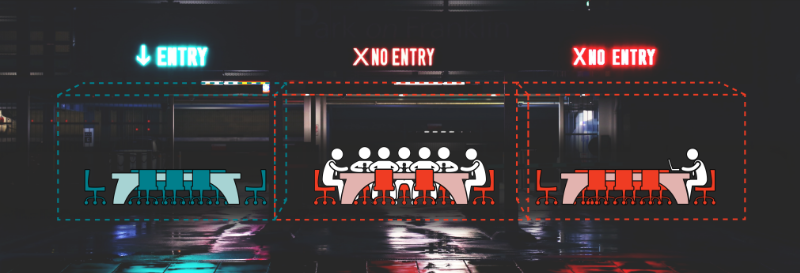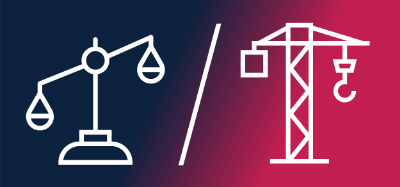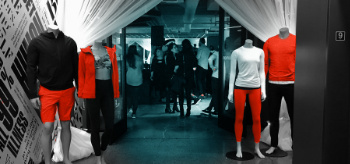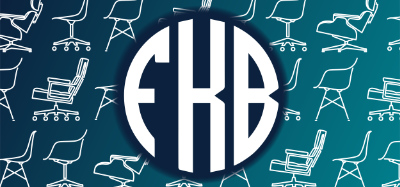Shhhh…what’s that sound?

In shared workplaces, who makes the rules?
What do you do when you see people breaking the rules? Some people certainly think the maintenance of order is worth disturbing the peace. Others think rules are meant to broken. In a world of shared workspaces, this can lead to conflict. In this month’s "On Our Minds", we’re talking about social norms in the workplace—how they are established and whose job it is to enforce them.
On our minds
It’s a story that’s played out in movie theaters, library research rooms, and train quiet cars since those things existed; someone is talking when or where they aren’t supposed to be. How do you respond? Are you ‘shoosher’? Or are you more of the ‘silent glare’ type? Maybe you appeal to a higher power, like management or a train conductor. Whatever the method, when someone in a group tries to re-establish a shared norm, things can get ugly.
This was the subject of a story we were fascinated by on WNYC radio: "Who Should Enforce the Rules in the Quiet Car?" It retold how a dispute with some noise-makers on a busy train almost came to blows. It got us thinking about the changing way that people navigate shared norms in a work environment.
In a traditional corporate office, you might think it would be straightforward to get people to agree on certain rules; no eating in the conference room, for example. The environment is private and people share a culture and set of policies. But shared norms—and our ability to navigate them—are funny things; they can evaporate in the presence of hierarchy. Explicit policies can abrogate implicit norms. Even the best of change management efforts can leave room for continued improvement. People start to rely on various hierarchy to enforce rules. If you’ve ever received an email from an office manager because some unnamed coworker is leaving dirty coffee cups in the cafe sink, or signs posted to tell people to clean up after themselves, you know this to be true.
At PLASTARC, we spend a lot of time working in and thinking about coworking spaces, which exist in a unique social context between public and private: only members are allowed in the space, but anyone who can afford a membership is welcome to join. Inhabitants are neighbors, but may not really know each other or share a culture. You might imagine this could cause issues if not properly addressed. Yet, by-and-large, these spaces are able to create an environment that welcomes everyone while still respecting their different notions of how a workplace should operate. You could argue that an environment without the power dynamic of management enforcement actually makes this easier, since it encourages people to treat the space as more of a public one, like a park or town square.
Whose norm is it, anyway?
A coworking space might post signage about a policy and have management staff enforce it from time to time. As designers, we’re also interested in how norms get propagated through less obvious design choices. For example, it’s important how the name of a space creates a certain expectation around it. Even though most people in coworking spaces today have probably never been inside an actual phone booth, giving that name to a room (like this one) lets users know how they are expected to use it. The same can be said of the "carriage cars" (team booths) and “libraries” (quiet shared spaces). The settings these rooms are named for may not even proliferate as they once did, but the expectations are still in force.
System failures lead to human failures
Design thinking encourages us to examine the assumptions and choices that lead to the current conditions. As we highlighted in our newsletter not too long ago, the first step of any endeavor is making sure you’re trying to solve the right problem. Often, what appears to be a failure of people and policy may actually be a failure of design.
In the example of the not-so-quiet train car, underlying conditions and design decisions may have made it difficult or impossible for some people to adhere to the rules. Families may want a calm, quiet place where they can all sit together—with the knowledge that children may make noise unexpectedly. Where should they go? Given no option that actually accommodates their needs, they do their best with the choices that remain.
Similar situations—in which a space doesn’t fit occupants’ needs—arise in the workplace. For instance, we’ve seen cases where people seem to be "misusing" conference rooms—working solo or in pairs in a room that is intended to be available for large group meetings. These workplaces could post and attempt to enforce a usage policy, but it’s first worth asking why people are using the room in this way. Maybe it’s the only quiet, private space available to them. Maybe it’s the only room with a large flat work surface. Maybe it’s the only place they have access to daylight or adequate climate controls. Designers can address some of these problems with furnishings that better fit the needs of the occupants, or with better customization options (our friends at Comfy can help!). Before making changes, though, it’s worthwhile to dig down and try to understand what underlying conditions might be causing people to behave the “wrong” way.
From the archives
Speaking of shared norms, remember last year when Hooters opened a coworking space in Tokyo? A unique take on multisensory design! At the same time, we were in the midst of our work with Verizon to open a coworking space in Singapore—APAC coworking gone wild!
Back in 2015, we wrote for Oculus magazine about "Architecture in the Social Data Era". Our passion for the use of data is not only the driving force behind PLASTARC’s work, but also behind the creation of the AIANY Social Science and Architecture Committee, which we co-founded a year later.
That’s all the time we have for this month, but don’t be a stranger! Drop us a line to let us know how you think design affects the way people behave in your workplace—just don’t type too loud...shhhhhhh!
In Case You Missed It
This month we’ve been connecting the big picture to all the little ones—from the role of architects in society to the role of a brand-inspired restroom product.

The Sherman Antitrust Act and Architecture
Peggy Deamer’s fascinating deep dive in the Avery Review examines the history of fee setting in architecture and the broader role of the profession in society.

Opening of lululemon office in Seattle
We joined the lululemon team for the debut of their newly-renovated space, designed around flexibility and movement.

Culture Amp: People Geekup
This panel of HR professionals discuss ways to cultivate employee wellbeing, improving workplace culture, and avoiding burnout.

Remembering Florence Knoll
March is Women’s History Month! This pioneer designer of the modern office is among the legends we plan to celebrate in our next newsletter.
Looking Ahead
We’re looking forward to these exciting opportunities to expand our knowledge and contribute to the study of workplace. See you there?





